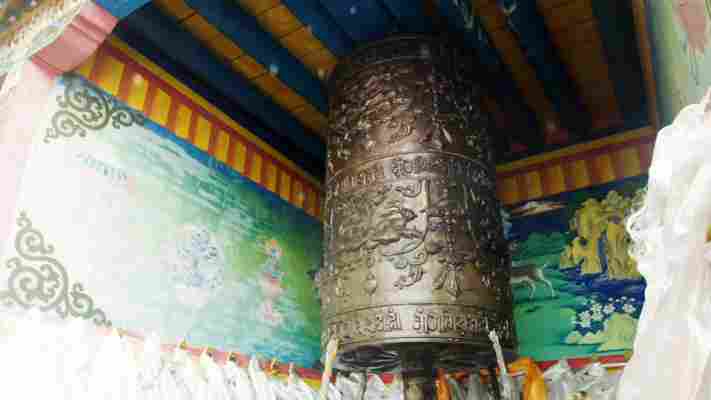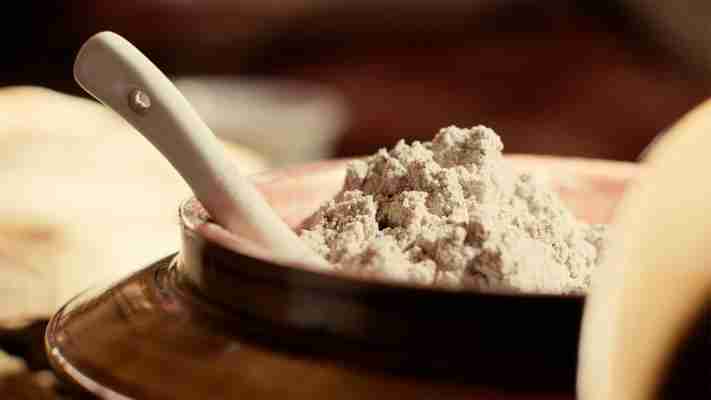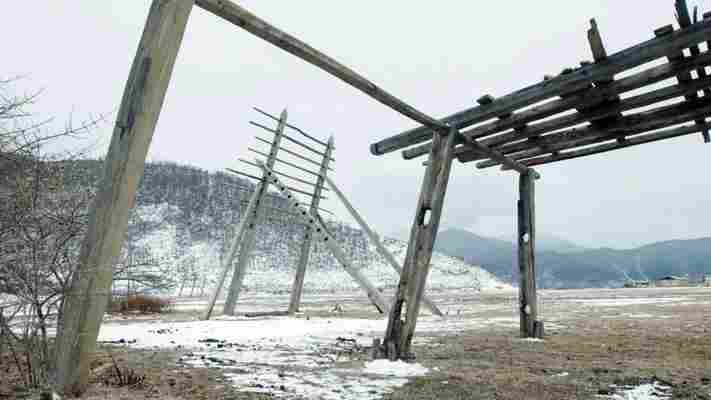

(Credit: Daniel Agha-Rafei)
Tsampa , a roasted, ground barley flour is ubiquitous in the ethnic Tibetan areas of the Himalayan region, encompassing areas between the Indian subcontinent and the Tibetan Plateau, along with the Tibet Autonomous Region and parts of Western China. It is quite literally mixed into the DNA of Tibetan people.
In a land where animal husbandry, religion and nature have formed a deeply spiritual and symbiotic relationship, tsampa has become engrained in Tibetan culture. It’s used to nourish the people, feed the cattle and safeguard the soul when offered as a sacrifice.
It is the first solid food many Tibetans eat as babies and one of the last elements of their being as their body is returned to the earth upon death. This circle of life has been slowing spinning for countless generations, much like the impassive Buddhist prayer wheels dotted across the mountainous landscape.

(Credit: Daniel Agha-Rafei)
The highest elevations of the Himalayan region have limited arable land and an extremely harsh climate. Barley is particularly precious, as it’s one of the only viable crops at such high altitude. It is planted in the spring and harvested in the summer, when bundles of golden sheaves are laid out to dry on towering, wooden drying racks under the sun’s unforgiving rays. These medieval-looking structures, which are covered by the harvest during summer, are left abandoned in winter, casting ghostly shadows of an abundance that once was.
After the barley has dried, it is roasted and ground to form tsampa. Traditionally, subsistence farmers would carefully work this valuable crop into tsampa before separating it into three portions: one for the family, one for the animals and one to donate to the monastery.
Tibetan Buddhist monks use tsampa offerings to bake blessed bread for worshipers, mould religious sculptures and to provide food for themselves. Tsampa is also used in sang , a type of powdered incense thrown into monastery fireplaces, sending up thick, dark smoke from ancient chimneys as an offering and blessing for good fortune.
(Credit: Daniel Agha-Rafei)
It is tough to eke out an existence on the upper reaches of the Tibetan Plateau, with barley being one of the only arable crops on the rooftop of the world.
(Credit: Daniel Agha-Rafei)
Ask any Tibetan and they will tell you that the best way to eat tsampa is in a steaming bowl of salted yak butter tea. The roasted barley flour is placed into a bowl and the perfect ratio of tea is cautiously poured over. The mixture is carefully gathered together, between fingertips often callused from exposure to the elements, and slowly worked into a dense, mouthful-sized ball. Once eaten, the filling fare sits heavy in the stomach, satiating hunger, warming cold bodies from the inside out, and has provided nourishment for generations of Tibetans.
Versatile tsampa can also be used to thicken soups, or can be baked into breads, pastries and biscuits. It can accompany slabs of yak meat and cheese or preserved vegetables, and mixed with hot spices or sugar, depending on the prevalence or preference of the ingredients.
Traditionally, tsampa mixed with yak butter was, and often still is, used as a cure-all medicine, be it slathered on a particularly painful tooth or as an aid for indigestion. Generations of Tibetans have extolled its healing benefits.
(Credit: Daniel Agha-Rafei)
Infants are weened onto tsampa from around one month old, with a small pinch of the flour mixed into warmed water or yak milk. While half Tibetan, I was brought up in England, and received my initiation to the dish as a young child, when I would spend summers with family friends in Kalimpong at the orphanage where my Tibetan father grew up.
In 1950, China enforced its long-held claim to Tibet, and in 1951, Tibetan leaders signed an agreement giving China control over Tibet’s external affairs. Since this period, and following a Tibetan rebellion in 1959, many Tibetans have settled in Kalimpong, a Himalayan hill town in India, near Darjeeling, not far from the Chinese border, and once an outpost for offshoots of the ancient Silk Road and Tea Horse Road trading routes.
As a young girl, I was drawn to tsampa, most likely because of the sense of belonging it gave me, rather than the taste. The nutty smell of roasting tsampa intermingled with the milky, rich, enveloping scent of freshly churned yak butter tea transports me to childhood summers in Kalimpong. Eating tsampa when I visited India helped me to connect to my Tibetan roots, even if that meant connecting with an immigrant community in a foreign country.
(Credit: Daniel Agha-Rafei)
Tsampa can play an equally important role in death as at the beginning of life.
Some ethnically Tibetan areas lie at such high altitude that the earth is too solid to bury a body and there is only a limited supply of firewood for cremation, so the deceased are given ‘sky burials’. During this funeral process, bodies are sliced into small, manageable pieces for vultures to consume. Tsampa is thrown on the flesh to absorb the blood and stop it from splattering on those tasked with breaking up the body. The final part of the ritual, after the flesh has been eaten, involves grinding down the bones and mixing the pulp with tsampa for the birds to finish off. If requested before death, in certain areas, some of the bone and tsampa debris will be taken to the monastery to sculpt into religious statues, and the skull used in the figurine of a protector god.
Tibetan Buddhists believe that after a person’s spirit leaves its body, the physical remains do not hold as much reverence. They subscribe to the belief that all sentient beings can be reincarnated, so any human could be reborn as an animal and any animal could enter its next life as a human on the path to enlightenment. Feeding the vultures, on the same Buddhist cycle of rebirth, life and death, therefore offers good karma and is viewed as a happy occasion. The body breakers carry out their duty whilst smiling, to help the spirit into its next life.
(Credit: Daniel Agha-Rafei)
The Tibetan diaspora is nowadays spread across China, India, Nepal and many other countries. And while Tibetan people are more separated than ever, tsampa is the glue that binds the ethnic group together.
Although many of the ancient and religious traditions of Tibetan people are hard to practise outside of its borders, tsampa is an easy way to recreate a small taste of home, even for second- or third-generation Tibetans living elsewhere. The act of roasting and grinding barley to make tsampa is simple, and has barely changed since the first Tibetan ancestors started farming.
(Credit: Daniel Agha-Rafei)
There is only one surviving photo of my father’s Tibetan family members: a well-worn, black-and-white photograph of my grandfather. I grew up staring at the photo of this handsome young man, with high cheekbones and a strong nose, wearing a proud expression and feather in his cap.
Auspicious Tibetans traditionally burn the worldly possessions and photographs of those who have passed on to the next life, so they will not be tied to anything from their past life. This treasured photo was saved from the purge by my father’s progressive Han Chinese stepfather, who remarried the first wife of my grandfather, and handed the photo down to my father.
(Credit: Daniel Agha-Rafei)
I share my first name, Nyima, with my Tibetan grandfather, a leather merchant from Shigatse, and the seat of the Panchen Lama, the second most important religious figure in Tibetan Buddhism after the Dalai Lama. In the 1930s and 1940s, my grandfather would do business between his hometown and Kalimpong, which was once a gateway for trade between India and the Tibet Autonomous Region. It is located around 250km due south of Shigatse, with the route crossing one of the most treacherous mountain ranges in the world.
Tsampa was, and still is, essential for Tibetan traders, herders, farmers and labourers, who are often nomadic and out in the wilderness for days at a time. It has been carried by generations of Tibetans scaling inhospitable mountain passes along trading routes. A pocketful of roasted barely flour mixed with fresh water is not only convenient, but also makes for a filling meal, and is even better when spare tea leaves or calorific yak butter is available. I imagine my own Tibetan grandparents filling their saddlebags with tsampa when setting out on their last trip from Shigatse, perhaps unaware that they would never see their hometown again.
(Credit: Daniel Agha-Rafei)
Mineral-rich tsampa is known for its nutritional benefits: high in protein, vitamins and fibre, it can help lower cholesterol and is one of nature’s best energy foods, essential for Tibetans living labour-intensive lives at high altitude.
(Credit: Daniel Agha-Rafei)
When I was 20, I moved from England to China and stayed for eight years, which allowed me to learn more about my heritage by visiting remote regions of the country’s ethnically Tibetan areas. In Sichuan, I lived off the grid with a Tibetan horseman and his family. The horseman and his wife spoke no English, so we conversed in stilted Tibetan, halted Mandarin and the language of food.
We consumed tsampa in its many forms, mixed with salted yak butter tea or baked into bread; and drank chang , a homemade barley beer and tsampa by-product. We called on far-flung neighbours as we journeyed on horseback and hunkered down on stools by hearths feasting and drinking.
In Tibetan culture, every stranger who comes to the door is welcomed in as a friend, and there is always a pot of tea boiling on the stove, warming the entire house.
(Credit: Daniel Agha-Rafei)
Ringha Temple, in China’s Yunnan province, is one of the most important temples in the area, with the fifth Dalai Lama said to have once visited and countless Tibetan Buddhists stopping to pray on their journeys. Just below the hill on which Ringha Temple sits is a small hamlet, often referred to as Ringha Village. Ringha Village will forever be my happy place – the place my imagination takes me to when the stresses of life seem overwhelming.
When working as a magazine editor, I visited the village, which is made up of a handful of extended families who live in traditional Tibetan farmhouses at over 3,000m above sea level and have been working the land for generations. While there to review a hotel, I ended up learning more about my Tibetan culture and Tibetan traditions from this community than I had for most of my life, by spending my days with one of the local families.
As a young child, I always had an affinity for pink, as many girls my age did. However, I never grew out of this phase, and magenta can always be found about my person even to this day. When I visited the village, the first thing that struck me about the women was that they all wore bright magenta headbands and many dashes of pink in their traditional Tibetan clothing. A Tibetan friend once joked with me that Tibetans don’t like to travel far, with people’s reincarnations often being recognised within the same family or village. Yet, he said, with more Tibetans moving overseas in the last century, the net for discovering reincarnations is constantly being widened around the world. I questioned myself: has my fondness for the colour been the hangover of a previous life in Tibet.
(Credit: Daniel Agha-Rafei)
Tibetans have always welcomed me in as one of their own and passionately taught me about our shared culture, even when I was young. However, I spent my childhood in England trying to fit into a small town and would avoid acknowledging my Tibetan cultural heritage. But one day, in my early teens, I was mortified to be picked up in the town centre by my father with a fully robed Tibetan monk (not pictured) in his car – my dad had managed to find the only other Tibetan in town at the supermarket and had immediately invited him home for food.
His name was also Nyima, the first person I had ever met who shared my name. He asked me if I remembered a past life. At the time, I found his question absurd. But when breathing in the thin air at high altitude in Ringha Village, I felt lightheaded as a dizzying sense of spirituality allowed me to consider the possibility of reincarnation. Perhaps my past life had led me back to this place and given me my fondness for tsampa.
(Text and production by Nyima Pratten ; video and images Daniel Agha-Rafei )
This article is part of a special ‘Immigrant Edition’ of Soul Food , a BBC Travel series that connects you with cherished memories through comfort foods from around the world.
